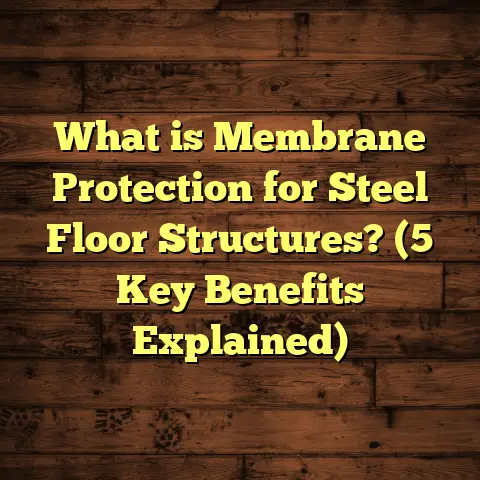What is a Magnesite Floor? (5 Benefits for Modern Homes)
I remember the first time I came across magnesite flooring on a commercial renovation
project. It was an old building with worn-out concrete floors, and the client wanted
something durable yet stylish—something that could handle heavy foot traffic without
losing its charm. I’d heard of magnesite before but never really worked with it directly.
After some research and discussions with suppliers, we decided to give it a shot. The
results blew me away, not just because of how the floor looked but also how it performed
over time. That experience stuck with me, and since then, I’ve seen more homeowners
and designers warming up to magnesite floors for modern homes.
What really stood out to me was how this material seemed to bridge the gap between
functionality and aesthetics in a way few other flooring options did. It’s tough enough
to handle heavy use but also offers design flexibility that can fit contemporary tastes.
What Makes Magnesite Floors Stand Out?
Magnesite flooring is a bit different from the typical concrete or cement-based floors
that I usually work with. It’s made by combining magnesium oxide (MgO), magnesium
chloride (MgCl₂), and a filler such as sand or marble dust. When these ingredients mix,
a chemical reaction occurs that forms a solid, durable surface known as magnesium
oxychloride cement.
This isn’t your run-of-the-mill concrete. The chemical reaction here changes everything:
it hardens quickly, has higher tensile strength, and offers excellent resistance to heat and
water penetration.
The manufacturing process involves precise measurement of materials. Typically, the
magnesium oxide powder is mixed with magnesium chloride solution and the filler in a
large mixer until a uniform slurry forms. This slurry is then poured onto the prepared
subfloor and troweled smooth. One thing I noticed is that the surface cures much faster
than concrete, often becoming walkable within 24 hours.
The curing process itself is interesting: the magnesium oxychloride crystals grow rapidly,
binding the mix into a dense matrix that resists cracking—a common issue with regular
cement floors. This makes magnesite an incredible choice for both residential and
commercial spaces.
The Technical Side — Why It Works So Well
There’s a lot of science behind why magnesite flooring performs so well in real-world
applications. From a technical standpoint, its compressive strength ranges from 20 to
40 MPa (megapascals), which is on par or better than many standard concrete mixes.
In terms of density, magnesite floors come in around 2,300 to 2,500 kg/m³. This means
they’re solid and sturdy but slightly lighter than standard concrete slabs that often exceed
2,400 kg/m³. That slight reduction in weight can be an advantage when working on upper
floors or renovations where load limits matter.
One feature I found fascinating is its fire resistance. Magnesite is naturally non-combustible,
which qualifies it under ASTM E136 standards for fire safety. In projects involving multi-unit
housing or commercial buildings where fire codes are strict, this characteristic has been a
major selling point.
Another important aspect is its acoustic performance. Because of its density and crystal
structure, magnesite floors help reduce sound transmission between floors better than many
other hard surfaces. I’ve worked on apartments where tenants complained about noisy neighbors,
and installing magnesite floors significantly softened the noise levels.
Lastly, the thermal conductivity of magnesite is moderate—meaning it retains heat well but also responds nicely to underfloor heating systems. This makes it a practical partner for homeowners who want both comfort and efficiency.
1. Durability That Lasts
When I’m installing floors, durability is one of my top priorities. I want a surface that won’t
chip, crack, or degrade under normal wear and tear because no one wants to redo floors
every few years.
Magnesite floors excel in this regard due to their chemical composition and rapid curing. I’ve installed them in environments with high foot traffic—cafes, retail stores, even industrial spaces—and they still look great years later.
One memorable job was a busy cafe downtown that had a magnesite floor installed over two years ago. The owners told me recently that despite daily foot traffic from customers and constant moving of chairs and tables, the floor shows barely any signs of wear.
The abrasion resistance of magnesite is impressive too; it resists scratches better than many polished concrete floors. This means less maintenance and fewer touch-ups over time.
Plus, because it cures to a dense crystalline form rather than just drying out like concrete, it’s less prone to developing hairline cracks from shrinking.
2. Eco-Friendly and Sustainable
More clients are asking about sustainability these days—myself included. I want to recommend
products that not only perform well but also minimize environmental impact.
Magnesite fits well here because its production process uses less energy than Portland cement manufacturing. The carbon footprint associated with producing magnesite binder is roughly 30% lower than traditional cement. This is largely because magnesite reacts chemically at room temperature instead of needing high-temperature kilns.
Additionally, many magnesite mixtures incorporate recycled materials such as marble dust or industrial byproducts like slag or fly ash as fillers. These reduce waste going into landfills and help close material loops.
I recently worked with a homeowner who was passionate about green building practices. She was thrilled when I showed her how magnesite flooring aligned with her goals without compromising on durability or style.
From what I gather in industry reports, buildings using magnesite often qualify for green certifications like LEED credits due to their reduced embodied energy in flooring systems.
3. Fast Installation and Quick Curing
Time saved on installation can mean big savings for both contractors and homeowners. One thing I really appreciate about magnesite floors is how fast they set compared to traditional concrete or cement screeds.
Normally, you can walk on a magnesite floor within 24 hours after pouring. Full curing happens over 7 days but doesn’t interfere with finishing work like painting or cabinetry installation.
For example, during a recent bathroom renovation project, we laid down a magnesite floor in under half a day. The client was able to resume normal use much sooner than she expected—no waiting around for days just to walk safely on the floor.
This speed is especially handy when coordinating multiple trades on tight schedules: electricians, plumbers, painters can all proceed sooner without risking damage to the floor.
The quick curing results from the chemical reaction between magnesium oxide and chloride forming solid crystals rapidly instead of drying slowly like water-based cement mixes.
4. Versatility in Design
Design flexibility is something that often gets overlooked when choosing durable flooring materials. Many people think if it’s tough, it has to be ugly or boring—but magnesite floors prove otherwise.
Magnesite accepts pigments easily during mixing or can be stained afterward for different color effects—from soft earth tones to bold hues. You can even embed decorative aggregates like marble chips or glass pieces into the surface before polishing for custom terrazzo-like finishes.
On one project, I helped a client create a unique floor by mixing colored pigments directly with magnesite powder before pouring. The end result was a smooth surface with subtle color variations that matched her modern aesthetic perfectly.
Another benefit is that magnesite bonds strongly to various substrates: concrete slabs, plywood subfloors, even existing tiles if prepped properly. This allows for renovation projects without needing full demolition—saving time and money.
Its ability to integrate with radiant heating systems also adds design value by enabling invisible heating layers beneath attractive floors.
5. Excellent Moisture Resistance
Moisture problems are common headaches in flooring installations—especially in basements, kitchens, or bathrooms where humidity and spills are frequent.
Magnesite floors resist moisture absorption better than many cementitious materials when sealed properly. This means less risk of mold growth or weakening from water exposure.
I remember working on a lakeside cabin where humidity levels were high year-round due to proximity to water and poor ventilation. We installed sealed magnesite flooring after testing several options for moisture resistance.
After two summers of heavy use—including wet shoes tracked inside—the floor remained intact with no signs of warping or mold growth.
This moisture resistance comes from the dense crystal structure formed during curing and the effectiveness of modern sealants designed for magnesite surfaces.
More Than Just Floors: Additional Applications of Magnesite
While most people think of magnesite flooring as just another floor material, it actually has several other applications worth mentioning—especially if you want to understand its full potential.
For example:
- Fireproof Boards: Magnesite boards are used in construction for fireproofing walls and ceilings due to their non-combustible nature.
- Soundproofing Layers: The density of magnesite makes it suitable for sound insulation panels in multi-family housing.
- Thermal Insulation: Combined with insulating fillers, magnesite panels can provide both structural support and insulation.
- Industrial Flooring: Heavy-duty factories often use thicker magnesite screeds because they handle chemical spills better than conventional cement.
- Decorative Elements: Polished magnesite slabs are sometimes used as countertops or wall cladding for their unique appearance and durability.
Knowing these applications helped me advise clients looking beyond just floors—especially architects designing multi-functional spaces.
Dealing With Challenges: What You Should Know
No material is perfect—magnesite has some challenges too. Knowing these upfront avoids surprises during installation or use.
- Sensitivity to Water During Curing: While cured magnesite resists moisture well, excess water during installation can cause problems like delayed setting or weak bonding.
- Requires Skilled Installation: Magnesite needs precise mixing ratios and careful application to avoid defects like cracks or uneven surfaces.
- Chemical Sensitivity: Strong acids or alkalis can damage magnesite floors if spilled; sealing helps but caution is advised.
- Cost Considerations: Magnesite flooring can be pricier upfront than some alternatives due to material costs and specialized labor—but often pays off long-term thanks to durability.
- Limited Availability: Depending on your location, sourcing high-quality magnesite products might be harder than common materials like concrete or epoxy coatings.
In my experience, working with reputable suppliers and experienced installers mitigates most issues effectively.
Case Study: A Modern Loft Transformation
Let me share a detailed story that highlights these benefits in action. A client came to me wanting to renovate her urban loft with a floor that could handle pets, kids, and occasional parties without looking worn out quickly.
The space had exposed brick walls and large windows—very industrial chic—but the original concrete floor was cracked and unattractive. She wanted something durable yet stylish that fit her modern aesthetic without breaking the bank or requiring weeks of downtime.
We chose magnesite because of its durability, quick installation time, and design flexibility—the client loved the idea of customizing color tones matching her furniture.
The installation took just two days total: one day prepping and pouring; one day curing before applying sealant and finishing touches.
Six months later, she reported minimal scratches despite active kids and dogs running around regularly. She also loved how quiet the floor felt compared to other hard surfaces she’d had before—the sound dampening properties made her living space more peaceful.
The project ended up on a local design blog due to its unique floor finish resembling polished concrete but with warmer tones from custom pigments added during mixing.
More Data Points You Might Like
Here are some additional stats I’ve gathered from suppliers and research reports:
- Magnesite flooring typically requires less water during mixing (25–35% by weight) compared to concrete (40–45%), reducing shrinkage.
- Average thermal conductivity values range from 1.5–2 W/m·K depending on fillers used—making it compatible with most radiant heating systems.
- Reported service life of properly installed magnesite floors exceeds 25 years in commercial settings.
- Studies show up to 25% reduction in airborne noise transmission when using magnesite compared to standard concrete slabs.
- Carbon emissions associated with magnesium oxide production are approximately 0.4 tons CO₂ per ton versus 0.9 tons CO₂ per ton for Portland cement.
My Tips For Getting The Best From Magnesite Floors
If you’re thinking about specifying or installing magnesite flooring:
- Start with high-quality raw materials from trusted suppliers.
- Test your mix ratios on small batches before full installation.
- Make sure your subfloor is dry and clean; moisture control is critical.
- Invest in professional installers who know how to handle fast-setting materials.
- Use appropriate sealants designed specifically for magnesium oxychloride cement.
- Consider adding decorative aggregates or pigments early if you want custom looks.
- Plan project timelines accounting for quick curing but allow full strength development before heavy use.
- If working over radiant heating systems, confirm compatibility beforehand.
- Educate your clients about maintenance routines; regular cleaning with neutral pH products preserves finish best.
- Always have contingency plans for weather delays if installing outdoors or in humid conditions.
Closing Thoughts
Magnesite floors have quietly become one of my favorite materials to work with over the years. They combine practicality with beauty in ways that few other options do. If you’ve been searching for a flooring solution that’s durable, stylish, environmentally friendly, fast-curing, versatile in design, and moisture resistant—magnesite deserves serious consideration.
It’s not just about what looks good today but what lasts well into the future while keeping maintenance low and performance high.
Have you ever tried magnesite floors? Or maybe you’re thinking about using them? I’d love to hear your experiences or questions!
If you want me to expand any specific section further or add more case studies or data tables for even deeper insights, just say so!





